مقدمة
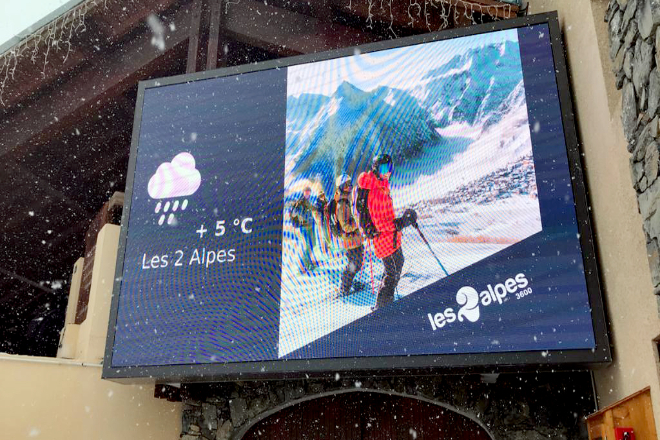
في عالم الجليد والثلج في نادي التزلج، شاشة عرض LED يلعب دورا لا غنى عنه.
ومع ذلك، تُشكّل بيئة درجات الحرارة المنخفضة تحديًا كبيرًا لأداء شاشة عرض LED. كيف يُمكن ضمان استمرار عمل هذه المعدات عالية التقنية في الثلج البارد؟
جدول المحتويات
1. لماذا يستخدم نادي التزلج شاشة عرض LED؟
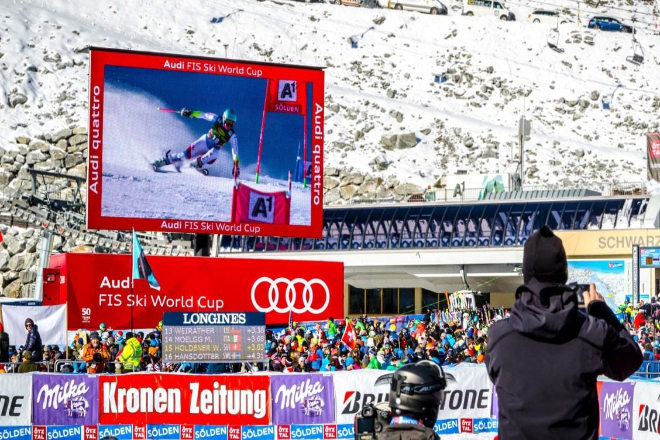
في نادي التزلج، نقل المعلومات مهم جدًا.
على سبيل المثال، أثناء المنافسة، يريد الجمهور معرفة من هو المتصدر، ويمكن لشاشة العرض LED عرض النتائج والتصنيفات في الوقت الفعلي، بحيث يمكن للجميع رؤيتها في لمحة.
يمكن للمبتدئين الذين يرغبون في تعلم التزلج أن يقرروا فورًا ما إذا كانوا يريدون التسجيل عندما يرون عبارة "دورة التزلج يوم السبت، عرض خاص للمبتدئين" على شاشة العرض.
إذا كان الطقس سيئًا والمسار الثلجي زلقًا، تُذكّر شاشة العرض الجميع بـ"الانتباه للسلامة". هذا النوع من التذكيرات الحميمة مريح وعملي، ويُشعر الناس بالراحة.
شاشة العرض LED هي "حجر امتصاص الذهب" لنادي التزلج.
على سبيل المثال، عند إقامة مسابقة، يتم وضع إعلان الراعي على الشاشة الكبيرة، ويمكن للجمهور رؤيته بوضوح، وسيرتفع تعرض العلامة التجارية على الفور.
يمكن للنادي نفسه أيضًا استخدام شاشة العرض للترويج، مثل إظهار لحظات التزلج الرائعة للأعضاء.
أو قم بتشغيل مقاطع الفيديو الترويجية للنادي لجذب أعضاء جدد وجعل الأعضاء القدامى يشعرون بمزيد من الراحة.
وبهذه الطريقة، يمكن أن ترتفع شعبية النادي ونشاط أعضائه.
لأجواء نادي التزلج أهمية بالغة، وشاشة عرض LED تلعب دورًا هامًا في هذا الصدد، إذ يمكنها التقاط أجمل لحظات التزلج.
على سبيل المثال، فإن الحركة البطيئة للرياضيين الذين يتقلبون في الهواء تخلق تأثيرًا بصريًا يثير الناس.
وفي منطقة الراحة، يمكن لشاشة العرض أيضًا تشغيل مقاطع فيديو موسيقية وعروض ضوئية.
على سبيل المثال، في الليل، ترفرف رقاقات الثلج، وتومض أضواء الشاشة والظلال، ومع الموسيقى الديناميكية، يجلس السياح معًا، ويشربون المشروبات الساخنة، ويتحادثون، ويلتقطون الصور، ويصبح الجو مليئًا بالحياة.
لا يسمح هذا المشهد للسياح بالاستمتاع فحسب، بل يسمح لهم أيضًا بمشاركته على وسائل التواصل الاجتماعي، مما يجذب المزيد من الأشخاص لتجربته.
بيئة نادي التزلج معقدة، ويجب أن تكون شاشة العرض الخارجية قادرة على تحمل درجات الحرارة المنخفضة والأمطار والثلوج. وتُظهر شاشات LED أداءً ممتازًا في هذا الصدد.
على سبيل المثال، في ظروف الطقس التي تزيد عن عشر درجات تحت الصفر، فإنه لا يزال بإمكانه العمل بشكل طبيعي دون تجميد أو شاشة سوداء.
علاوة على ذلك، فإن عمرها التشغيلي طويل للغاية، ولا داعي للقلق بشأن المشاكل لمدة تتراوح من ثلاث إلى خمس سنوات، وهو ما يوفر لك الراحة من القلق وتوفير العمالة.
وتسمح هذه المتانة للنادي بعدم القلق بشأن الأعطال المتكررة للمعدات، وتقلل من تكاليف الصيانة، وتضمن عدم تأثر تجربة السائحين.
الآن بعد أن أصبحت التكنولوجيا متقدمة جدًا، أصبحت وظيفة التحكم عن بعد لشاشات العرض LED عملية للغاية.
يتمكن الموظفون من تحديث محتوى الشاشة من خلال الهواتف المحمولة أو أجهزة الكمبيوتر دون الحاجة للذهاب إلى الموقع.
على سبيل المثال، قرر النادي إقامة تحدي التزلج بشكل مفاجئ.
يتمكن الموظفون من تحديث معلومات المنافسة على شاشة العرض ببضع نقرات فقط في المكتب، وهو أمر مريح وفعال.
علاوة على ذلك، يمكن تخصيص شاشة العرض وفقًا لاحتياجات النادي.
على سبيل المثال، يمكن تحويل شاشة العرض عند المدخل إلى شكل قوس، وهو ما يمتزج بشكل مثالي مع الطراز المعماري للنادي.
ليس جميلاً فحسب، بل يُتيح أيضاً عرض محتوى أوسع. هذه المرونة تُسهّل إدارة النادي.
2. ما هو تأثير انخفاض درجة الحرارة على شاشات العرض LED؟
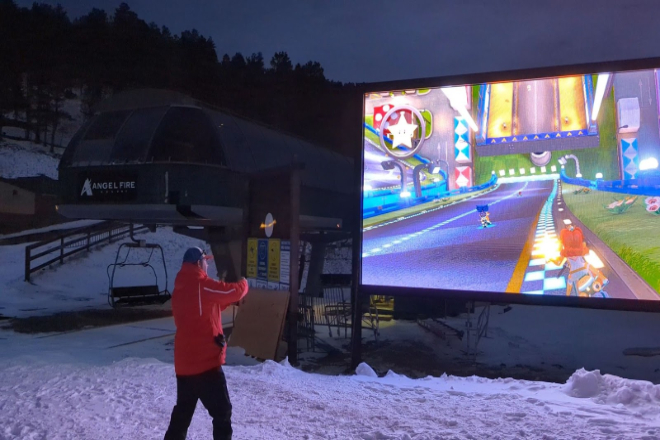
1) تأثير انخفاض درجة الحرارة على البنية المادية للشاشة
تخيل أنك وضعت قطعة بلاستيك في الثلاجة. عند إخراجها، ستجد أنها أصبحت هشة.
وينطبق الأمر نفسه على شاشات LED. فالمواد الداخلية، مثل الغلاف ولوحة الدائرة، تنكمش عند درجات حرارة منخفضة.
هذا مثل أنبوب الماء في الشتاء. من السهل أن يتشقق عندما يتجمد.
إذا انكمش كثيرًا، فقد يصبح الموصل مرتخيًا أو حتى يتشقق، وستصبح الشاشة بأكملها غير مستقرة.
بالإضافة إلى ذلك، قد تتسبب درجات الحرارة المنخفضة في تشوه الأجزاء البلاستيكية داخل الشاشة، مما يسهل تشقق الغراء. وبالتالي، تقلّص بشكل كبير قدرة الشاشة على مقاومة الماء والغبار.
2) تأثير درجات الحرارة المنخفضة على الكفاءة الضوئية وأداء الألوان لرقائق LED
رقاقة LED في الواقع رقيقة جدًا. فعندما تتغير درجة الحرارة، يتغير أداؤها.
عند درجات الحرارة المنخفضة، تتباطأ حركة الإلكترونات في الشريحة، تمامًا مثل النهر في الشتاء. يتدفق الماء ببطء، وتنخفض كفاءة الإضاءة.
بالإضافة إلى ذلك، تتأثر الألوان المختلفة بدرجة الحرارة بدرجات مختلفة.
على سبيل المثال، قد يكون اللون الأحمر جيدًا، ولكن اللون الأزرق قد يصبح باهتًا، مما يؤدي إلى تشويه اللون.
على سبيل المثال، قد تبدو الشاشة التي كانت في الأصل زرقاء ساطعة وكأنها زرقاء رمادية عند درجات الحرارة المنخفضة، مما يؤثر على التأثير البصري.
3) تأثير انخفاض درجة الحرارة على أداء المكونات الإلكترونية مثل دوائر القيادة ووحدات الطاقة
بالإضافة إلى شرائح LED، فإن المكونات الإلكترونية الأخرى في الشاشة تخشى أيضًا من البرد.
على سبيل المثال، قد تتسرب الكهرباء من المكثفات عند درجات الحرارة المنخفضة، تمامًا مثل الدلو المتصدع، وسيتدفق التيار بعيدًا عن المكان الذي لا ينبغي أن يتدفق فيه.
ستتغير المقاومة أيضًا، مما يؤدي إلى تيار غير مستقر، يشبه تدفق الماء في أنبوب الماء المتقلب، مما يؤثر على التشغيل العادي للشاشة.
قد يكون من الصعب أيضًا بدء تشغيل وحدة الطاقة، تمامًا كما لا يمكن للسيارة أن تبدأ في الشتاء، وقد لا تبدأ الشاشة بشكل طبيعي بسبب مصدر طاقة غير مستقر.
4) قضايا الموثوقية وتحسين تصميم المكونات الإلكترونية في البيئات ذات درجات الحرارة المنخفضة
في البيئات ذات درجات الحرارة المنخفضة، تشكل موثوقية المكونات الإلكترونية مشكلة كبيرة.
على سبيل المثال، قد يتجمد السائل داخل الشاشة، تمامًا كما يحدث مع سطح البحيرة في الشتاء. بمجرد تجمده، تصبح الدائرة الكهربائية عرضة لحدوث قصر كهربائي.
لمعالجة هذه المشاكل، فكّر المصممون في طرق عديدة. على سبيل المثال، استخدام مواد أكثر مقاومة للبرد يُشبه ارتداء "معطف قطني" سميك للعرض.
أو قم بتثبيت مستشعر درجة الحرارة في الشاشة، وعندما تكون درجة الحرارة منخفضة للغاية، يمكن تعديل الدائرة تلقائيًا للحفاظ على عمل الشاشة بشكل طبيعي.
وعلى الرغم من أن هذه التصاميم تزيد من التكلفة، إلا أنها تسمح للشاشة بالتوهج بشكل طبيعي في الشتاء البارد.
باختصار، تؤثر درجات الحرارة المنخفضة بشكل عام على شاشات العرض LED، ولكن من خلال بعض التصميم الذكي واختيار المواد، يمكنها الحفاظ على الأداء الجيد في البيئات الباردة.
3. استراتيجية تصميم شاشات العرض LED لحماية درجات الحرارة المنخفضة في نوادي التزلج
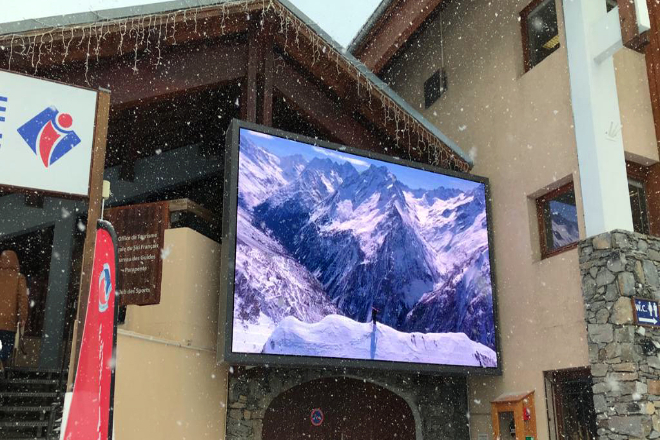
1). تصميم العزل لغلاف شاشة العرض
تخيل أنك تتزلج على الثلج البارد، يجب عليك ارتداء معطف سميك لتبقى دافئًا، أليس كذلك؟
ينطبق الأمر نفسه على شاشات عرض LED. للحفاظ على دفئها حتى في درجات الحرارة المنخفضة، يجب استخدام مواد عازلة على هيكلها.
على سبيل المثال، رغوة العزل أو ألواح العزل. تشبه هذه المواد وضع طبقة سميكة من القطن على شاشة العرض، مما يساعدها على الاحتفاظ بالحرارة ومنع تسرب الحرارة فجأة.
علاوة على ذلك، يجب أن يكون الغطاء مُحكم الإغلاق. وكما هو الحال عند الخروج شتاءً، يجب إغلاق أزرار ملابسك لمنع دخول الرياح الباردة.
غلاف شاشة عرض LED هو نفسه. استخدم حلقات مطاطية عالية الجودة مقاومة للماء لإغلاق الفجوات بإحكام.
حتى لا يتمكن الجليد والثلج والهواء البارد من الدخول، ولتتمكن المكونات الموجودة بالداخل من العمل بأمان.
2) تصميم نظام التدفئة
العزل وحده لا يكفي. أحيانًا يكون الجو باردًا جدًا في الخارج، لذا لا بد من وجود "سخان صغير" داخل الشاشة. وهذا يتطلب نظام تدفئة.
هناك العديد من الخيارات لعناصر التسخين، مثل أسلاك التسخين الكهربائية، أو أفلام التسخين، أو ببساطة تركيب ستارة الهواء الساخن.
ستارة الهواء الساخن تشبه مجفف الشعر الصغير. عندما تكون درجة الحرارة داخل الشاشة منخفضة جدًا، تنفخ تلقائيًا هواءً ساخنًا لرفع درجة الحرارة.
يجب وضع عناصر التسخين بعناية ولا يمكن وضعها بشكل عشوائي.
يجب توزيعها بالتساوي داخل الشاشة حتى يتم توزيع الحرارة بالتساوي، ولن تكون هناك حالة حيث تكون بعض الأماكن ساخنة ومتعرقة، وبعض الأماكن لا تزال باردة.
وبهذه الطريقة، تستطيع الشاشة دائمًا الحفاظ على درجة حرارة مريحة، وتستطيع المكونات الموجودة بالداخل العمل بشكل طبيعي.
بفضل هذه التصاميم، يمكن لشاشة LED الخاصة بنادي التزلج أن "تعيش بشكل جيد" في الثلج البارد، مما يوفر للجميع صورة واضحة ومستقرة!
4. استراتيجيات الصيانة والإصلاح لشاشات العرض LED في البيئات ذات درجات الحرارة المنخفضة
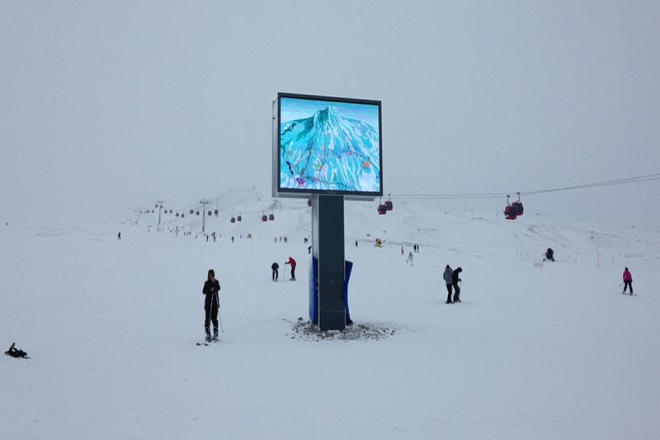
1) توصيات الصيانة اليومية
في البيئات ذات درجات الحرارة المنخفضة مثل نوادي التزلج، يعد الصيانة اليومية لشاشات العرض LED أمرًا مهمًا للغاية.
أولاً، يجب فحص إحكام إغلاق شاشة العرض بانتظام.
تمامًا مثل التحقق من وجود ثقوب في قفازاتك، إذا لم يكن الختم جيدًا، فسوف يدخل الهواء البارد والجليد والثلج ويؤدي إلى تجميد المكونات بالداخل.
لذلك، بعد كل تساقط ثلوج كثيفة أو عندما تنخفض درجة الحرارة بشكل حاد، يجب عليك التحقق بعناية من حلقة الختم والفجوة في شاشة العرض لمعرفة ما إذا كان هناك أي ارتخاء أو تلف.
بالإضافة إلى فحص الختم، فإن تنظيف الثلج أمر بالغ الأهمية أيضًا.
إذا تراكمت طبقة سميكة من الثلج على شاشة العرض، فلن تؤثر على تأثير العرض فحسب، بل ستؤدي أيضًا إلى زيادة العبء على القشرة وحتى سحق القشرة.
لذلك، يجب عليك استخدام فرشاة ناعمة أو مجفف شعر بانتظام لتنظيف الثلج، ولكن احرص على عدم استخدام أشياء صلبة لإزالة الثلج لتجنب خدش سطح شاشة العرض.
بالإضافة إلى ذلك، لا تنسَ فحص سلك الطاقة وكابل البيانات. قد تؤدي درجات الحرارة المنخفضة إلى هشاشتهما وسهولة كسرهما.
إذا وجدت أي أجزاء تالفة، قم باستبدالها في الوقت المناسب لتجنب حدوث ماس كهربائي أو ضعف الاتصال.
2) البحث عن المشاكل في الوقت المناسب من خلال أنظمة المراقبة عن بعد
الآن بعد أن أصبحت التكنولوجيا متقدمة للغاية، تم تجهيز العديد من شاشات LED بأنظمة مراقبة عن بعد.
يُعد هذا النظام بمثابة "مدبرة منزل ذكية" يمكنها مراقبة حالة عمل شاشة العرض في الوقت الفعلي.
في البيئات ذات درجات الحرارة المنخفضة، يمكن أن يساعدك في العثور على المشكلات المحتملة مسبقًا.
على سبيل المثال، يمكن لنظام المراقبة عن بعد مراقبة درجة الحرارة داخل الشاشة في الوقت الحقيقي.
إذا كانت درجة الحرارة أقل من قيمة الأمان المحددة، فسوف يصدر النظام إنذارًا تلقائيًا لتذكيرك بأن الشاشة قد تحتاج إلى التسخين أو الفحص.
بهذه الطريقة، يمكنك اتخاذ تدابير مسبقًا، مثل بدء تشغيل نظام التدفئة عن بُعد أو إرسال شخص إلى الموقع للفحص لمنع تجميد الشاشة.
بالإضافة إلى ذلك، يمكن لنظام المراقبة عن بعد مراقبة السطوع وأداء الألوان ومعلمات العرض الأخرى.
إذا وجدت أن سطوع في حالة انخفاض مستوى الضوء فجأة أو تشوه اللون، فقد يشير هذا إلى وجود مشكلة في شريحة LED أو دائرة التشغيل.
من خلال المراقبة عن بعد، يمكنك اكتشاف هذه المشاكل في الوقت المناسب، وترتيب الصيانة مسبقًا، وتقليل وقت التوقف.
باختصار، من خلال الصيانة اليومية الدقيقة والإدارة الذكية لنظام المراقبة عن بعد، يمكن لشاشة LED الخاصة بنادي التزلج الحفاظ على حالة جيدة في البيئات ذات درجات الحرارة المنخفضة وتوفير صور واضحة ومستقرة للزوار والأعضاء.
5. الخاتمة
بفضل استراتيجيات الحماية من درجات الحرارة المنخفضة المصممة بعناية وتدابير الصيانة العلمية، يمكن لشاشة LED الخاصة بنادي التزلج إظهار أداء ممتاز في البرد القارس وتقديم تجربة لا مثيل لها للزوار.
وأخيرًا، إذا كنت تريد معرفة المزيد عن شاشات LED، يرجى الحصول على اتصال معنا.
قد تكون مهتمًا بـ:
مقالات عن شاشات LED في الأندية الأخرى:
